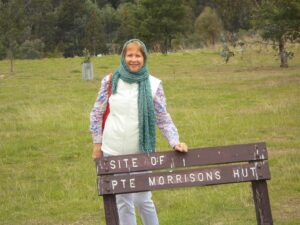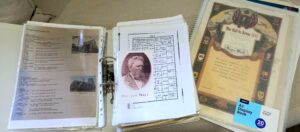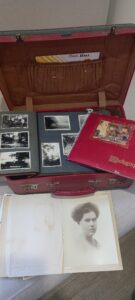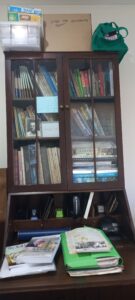Who in the family will take my family history notes?
Another year turns over and a question nibbles away in the back of my mind, like mice hidden in the interior walls of a house, sneaking the odd bit of cheese when you least expect it. On the floor in my studio tucked away in the garden sit three plastic crates, a transparent shade of white as plastic crates commonly are, revealing the edges of old newspaper cuttings, letters, photo albums, and photocopies of records passed down by distant cousins and my late aunt. Beside the crates too heavy for stacking higher up, is a wooden unit of two shelves stacked tightly with lever arch files, their spines facing out and covered by Marbig labels identifying my paternal and maternal ancestors, along with a regretfully much thinner file detailing the hubby’s side.
While it mightn’t sound like too much, these boxes and folders are the tip of the proverbial iceberg. Below the waterline are copious digital files of stories, family trees, scanned photographs, and certificates sitting in cloud storage, useful as long as someone knows how and where to find them.
Taking up the interest in her early 50s, mum’s older sister was our family’s genealogist. Mum and her two other siblings were happy to enjoy the fruits of Aunt Lila’s ever-patient research. Picking up on clues scrawled at the bottom of hard-to-read certificates, following up on hearsay and innuendos while the last of the old folk were around, paying attention to the detail, these were skills my aunt had honed over the years; family history was an interest well-suited to her temperament.
Diving down rabbit holes is part of the process, sometimes useful, sometimes pointless. In my aunt’s case, a few skeletons tumbled out of the letterbox, especially where my great-grandmother was concerned. I remember in mid-2001, Mum and her two sisters sat on my back terrace to pour over a file containing 19 pages of correspondence and affidavits between the Townsville Orphanage, Townsville Police, and the State Children Department, from 1914 to 1916. Its contents were released only after Mum wrote to the Freedom of Information Unit. The findings were profound, and shocking in a sad way. ‘Skeletons in the closet’ is a very apt phrase for hidden truths especially when it concerns the removal of children, a denial of identity, and even abandonment. Poverty carries many disguises.
As a young woman, I loved hearing the stories of my aunt’s discoveries, such as on one of her trips to the Mitchell Library in Sydney, when she found that our ancestor, George Morrison, had served under Lt John Bowen on HMS Lady Nelson as a private, and was part of the first white settlement in Van Diemen’s Land at Risdon Cove. After returning to New South Wales sometime in 1804, and following the repair of HMS Investigator, George Morrison served on that ship between December 1804 and April 1805, after its famous commander, Lt. Matthew Flinders had left the Colony to return to England. I used to say to my aunt: “Lila, when I retire I’ll be right into it (referring to the family history lark) !”
In 2005, sadly my aunt died. This led to my cousin clearing out her garage. Rob phoned: “Chrissie, there are some things here for you—with Mum’s instructions”. Around I went, and there on the floor near the roller door sat two large cardboard boxes and some loose foolscap folders. Taking me at my word my aunt knew who to pass her records on to. 
It wasn’t until I retired, and following a couple of years exploring my maternal family history, that I realised how little I knew about Dad’s side. One cousin led to another, before hitting gold in 2018 with a distant cousin connected by our three-times great-grandfather William Wall. For 20 years Graham had been the Wall family historian. The emails and phone calls that followed over the subsequent two years led me to his doorstep armed with a laptop, camera, notebook and pen.
Graham opened the door and graciously invited me in. Entering his office, I noted a room that had no use for a bed: it was a treasure trove, albeit the furniture utilitarian. On top of a wide sturdy desk with side drawers, coupled with an office chair of some quality, stood a desktop computer, and reading lamp. Next to the desk was a half wall topped by a bank of windows that let a good amount of light in. I liked that. Turning around, either side of the door we had just walked through, I faced two walls covered from floor to ceiling with shelves stocked end to end with neatly labelled upright lever arch folders…. my-oh-my I thought, gazing in wonder.

George Louis Wall and family.
As a family historian, Graham had started the Wall Family project long before emails became a ‘thing’. His research was comprehensive and exhaustive. No stone was left unturned as he investigated and examined the lives of William Wall’s 13 children (the currency lads and lasses) and at least five generations thereafter. Along with William’s surviving children, Graham had also examined the details of six infants who did not survive, born of Mary Long and Eliza Clarke, William’s wives. Graham and I descended from Mary Long, the first wife.
My cousin should have been a professional archivist. Every letter and corresponding responses were filed in a system any librarian would be proud of. The thing was, Graham loved the research, like I do! Only he set such a wide scope, a journey that took many fascinating and rewarding years, but as life around work and health sometimes gets in the way, Graham reached a point where the writing part was a bridge too far. It’s a trap that awaits us all, and a timely lesson for me as I reflected on my enthusiastic approach to researching the Hallams and Lewises on Mum’s side.
Soon after meeting in person we struck a deal: I could access Graham’s records and connect with the wider Wall clan—those still living, with a promise that I do the write-up. Fast-forward to the end of 2021 and The Wall Family weaving the threads of memories was published, with acknowledgements, thanks and careful referencing to Graham Wall and members of the wider Wall clan, who generously shared their stories, photographs and records so that our Wall story could be told. It was a daunting task largely due to the challenge of scope and structure. I wanted the Wall’s history to engage readers not with facts and figures alone, but to leave them with a better understanding of the social history that unfolded in colonial Australia, in the context of our ancestors’ lives.
So here I am, a couple of years shy of 70 and yet to write about Mum’s side. But after that…..what happens to the records? I’m wondering who to pass the baton to. In time a solution will present itself. The point is, don’t leave it too long to think about your own research and papers. Get the story down, share it, but then what to do with all that hard work? The papers and paperwork? That is the question.




Fortunately for me, one of my daughters loves solving puzzles as much as I do and will take over where I leave off.
That’s great to hear Di.
Christine, thank you so much for your story. It resonates closely to me and my situation. Unless any of my grandchildren show an interest I may have to donate everything to a library or historical society. I wrote all the stories and sent them to all my cousins etc. A couple sent polite responses, some didnt even bother to answer, so no interest there.
I hope you find someone keen to continue this very important work.
Hi Julie, it’s disheartening sometimes isn’t it? At least if the family know what you’ve ultimately done with the records, they know were to go should someone later on develops an interest. It might skip a generation.
Hi Christine: Have just stumbled across this site while researching Claus Sturwohld, who is also my great-great grandfather, through Ceclia Sturwolhd! We should chat. and compare the research we have done! What is the best way of doing this??
Hi Debra, I’ll drop you an email. How exciting!